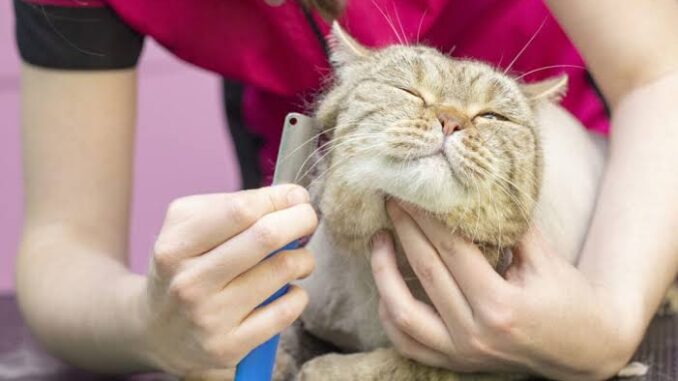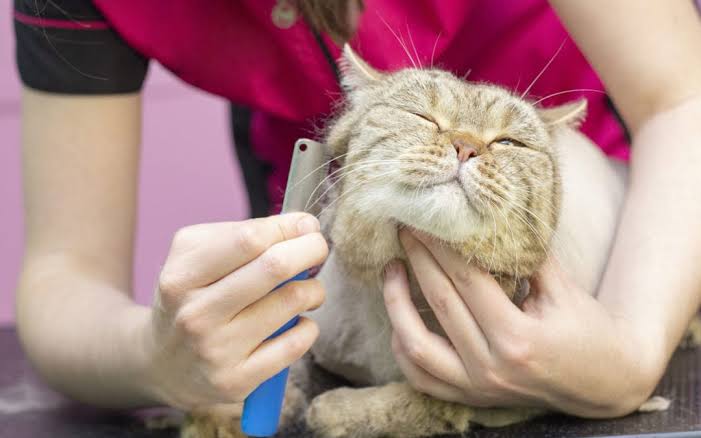
How to Groom Your Cat at Home: Cats are famously self-cleaning creatures but that doesn’t mean they don’t need a little help. Grooming your cat at home isn’t just about appearances. It plays a crucial role in their health, comfort, and the bond between you and your feline friend. From reducing shedding and preventing hairballs to checking for parasites or skin issues, home grooming is a routine every cat owner should learn.

In this detailed guide, we’ll walk you through how to groom your cat at home step by step, what tools you’ll need, grooming techniques by fur type, and answers to frequently asked questions.
Why Grooming Your Cat Matters
Even though cats groom themselves regularly, they still benefit from human-assisted grooming. Here’s why:
- Prevents matting and tangles, especially in long-haired breeds
- Reduces shedding and hairballs
- Keeps skin healthy by distributing natural oils
- Spots fleas, ticks, wounds, or skin conditions early
- Strengthens your bond with your cat through gentle touch
Routine grooming also gives you insight into your cat’s physical condition and comfort levels, potentially alerting you to health issues early.
Essential Tools for Cat Grooming
Before diving into grooming, gather the right tools:
1. Brushes & Combs
- Slicker brush – Best for long-haired cats
- Rubber grooming glove or brush – Ideal for short-haired cats
- Wide-tooth comb – Great for detangling knots
- Flea comb – Detects and removes fleas or flea dirt
2. Nail Clippers
- Cat-specific clippers with a safety guard are essential.
3. Pet Wipes or Damp Washcloths
- For spot cleaning dirt, especially around the paws or face.
4. Cat-Safe Shampoo
- Use only when necessary and ensure it’s designed for cats.
5. Towels and Treats
- Towels for drying or wrapping your cat, and treats for positive reinforcement.
Optional extras include ear-cleaning solutions, toothbrushes, and grooming tables for more comprehensive care.
Step-by-Step Guide to Grooming Your Cat at Home
Step 1: Create a Calm Environment
Choose a quiet, warm room without distractions. Gently pick up your cat or invite them into your lap or onto a grooming table. Speak softly and pet them to help them relax.
Tip: If your cat is skittish, try grooming after a meal or play session when they’re more relaxed.
Step 2: Brushing Your Cat
Short-Haired Cats
- Use a rubber grooming brush or glove.
- Brush in the direction of hair growth.
- Aim for 1–2 sessions a week.
Long-Haired Cats
- Use a slicker brush followed by a wide-tooth comb.
- Focus on common matting areas: behind the ears, under the legs, and around the tail.
- Daily brushing is recommended.
Tips for Brushing Success:
- Start with short sessions (5–10 minutes).
- Offer treats during and after.
- Stop if your cat shows signs of distress.
Step 3: Checking the Ears, Eyes, and Teeth
Ears
- Look for wax buildup, redness, or signs of mites.
- Use a cotton ball dampened with a cat-safe ear cleaner to wipe visible areas only.
Eyes
- Use a damp cloth to wipe away tear stains.
- Any persistent discharge may indicate an infection.
Teeth
- Brushing your cat’s teeth 2–3 times per week can prevent dental disease.
- Use a cat toothbrush and flavored feline toothpaste.
Note: Never insert anything deep into the ear canal or use human products.
Step 4: Nail Trimming
Trim nails every 2–4 weeks, depending on how active your cat is.
How-To:
- Gently press the paw to extend the claws.
- Clip only the translucent tip—avoid the pink area (quick), which contains nerves.
- If your cat resists, trim one or two claws at a time over several days.
Safety Tip: Keep styptic powder on hand in case you accidentally nick the quick.
Step 5: Bathing (If Needed)
Most cats don’t need regular baths, but exceptions include:
- Cats with skin conditions
- Long-haired cats with oily coats
- Cats that get into something sticky or dirty
Bathing Steps:
- Fill a sink or tub with a few inches of lukewarm water.
- Wet your cat gently using a cup or sprayer.
- Lather with a small amount of cat-safe shampoo.
- Rinse thoroughly and towel dry.
Pro Tip: Use a second towel to wrap your cat burrito-style for drying and calming.
Step 6: Cleaning the Rear and Feet
Check for litter or debris stuck in the fur, especially in long-haired cats.
- Use pet wipes or a damp cloth for spot cleaning.
- Trim excess fur around the rear if needed (called a sanitary trim).
Also check paw pads for dryness or small injuries.
READ ALSO: The Best Cat Foods for Sensitive Stomachs
Grooming By Coat Type
Short-Haired Cats
- Brush weekly
- Rarely need baths
- Easier to manage but still shed
Long-Haired Cats
- Daily brushing needed
- Prone to matting
- May benefit from professional grooming every few months
Hairless Cats (e.g., Sphynx)
- Wipe down with warm cloth or mild cat wipes every few days
- Bathing every 2–3 weeks to remove skin oils
- Moisturize with cat-safe lotions as needed
Handling a Resistant Cat
Not every cat enjoys grooming and that’s okay. Here are ways to ease them in:
- Start young. Kittens are more adaptable to grooming routines.
- Keep sessions short. Stop before your cat gets frustrated.
- Use positive reinforcement. Treats, petting, and a calm tone go a long way.
- Try different times of day. Post-nap or post-meal grooming often works best.
- Work in parts. Groom the back today, paws tomorrow.
In some cases, you may need to consult a professional groomer or a vet if grooming becomes too difficult.
FAQs
How often should I groom my cat?
It depends on coat type:
- Short-haired cats: once a week
- Long-haired cats: daily
- Hairless cats: every 2–3 days (wipes) and occasional baths
Can I use human shampoo on my cat?
No. Human shampoos (even baby ones) can irritate a cat’s skin. Always use a cat-specific formula.
What should I do if my cat has matted fur?
Use a detangling spray and wide-tooth comb. If mats are too tight, don’t cut them with scissors—you may injure your cat. Use clippers or visit a groomer.
How do I clean my cat’s ears?
Use a cat-safe ear cleaner and gently wipe the outer ear with a cotton ball. Never insert Q-tips deep into the ear canal.
Do indoor cats need grooming?
Yes. Even though indoor cats stay cleaner, they still shed, develop tangles, and benefit from nail trims and skin checks.
What if my cat hates being groomed?
Start slowly, use treats, and break sessions into small steps. For persistent resistance, ask your vet about calming sprays or consult a feline behaviorist.
Leave a Reply
You must be logged in to post a comment.